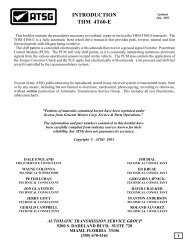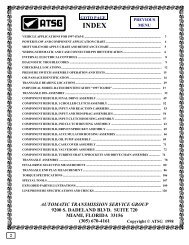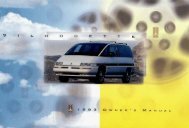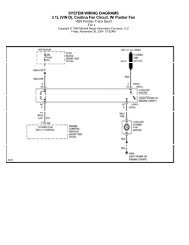Controls
Controls
Controls
Create successful ePaper yourself
Turn your PDF publications into a flip-book with our unique Google optimized e-Paper software.
Your Driving and the Road<br />
1 Freeway Driving<br />
Mile for mile, freeways (also called<br />
thruways, parkways, expressways,<br />
turnpikes, or superhighways) are the<br />
safest of all roads. But they have their<br />
own special rules.<br />
The most important advice on freeway<br />
driving is: Keep up with traffic and keep<br />
to the right. Drive at the same speed most<br />
of the other drivers are driving. Too-fast<br />
or too-slow driving breaks a smooth<br />
traffic flow. Treat the left lane on a<br />
freeway as a passing lane.<br />
At the entrance there is usually a ramp<br />
that leads to the freeway. If you have a<br />
clear view of the freeway as you drive<br />
along the entrance ramp, you should<br />
begin to check traffic. Try to determine<br />
where you expect to blend with the flow.<br />
Try to merge into the gap at close to the<br />
prevailing speed. Switch on your turn<br />
signal, check your mirrors and glance<br />
over your shoulder as often as necessary.<br />
Try to blend smoothly with the traffic<br />
flow.<br />
Once you are on the freeway, adjust your<br />
speed to the posted limit or to the<br />
prevailing rate if it’s slower. Stay in the<br />
right lane unless you want to pass.<br />
Before changing lanes, check your<br />
mirrors. Then use your turn signal.<br />
Just before you leave the lane, glance<br />
quickly over your shoulder to make sure<br />
there isn’t another vehicle in your “blind”<br />
spot.<br />
Once you are moving on the freeway,<br />
make certain you allow a reasonable<br />
following distance. Expect to move<br />
slightly slower at night.<br />
When you want to leave the freeway,<br />
nove to the proper lane well in advance.<br />
f you miss your exit do not, under any<br />
ircumstances, stop and back up. Drive on<br />
o the next exit.<br />
The exit ramp can be curved, sometimes<br />
pite sharply.<br />
The exit speed is usually posted.<br />
Reduce your speed according to your<br />
speedometer, not to your sense of motion.<br />
4fter driving for any distance at higher<br />
speeds, you may tend to think you are<br />
going slower than you actually are.<br />
Before Leaving on a<br />
Long Trip<br />
Make sure you’re ready. Try to be well<br />
rested. If you must start when you’re not<br />
fresh -- such as after a day’s work --<br />
don’t plan to make too many miles that<br />
first part of the journey. Wear comfortable<br />
clothing and shoes you can easily drive<br />
in.<br />
Is your vehicle ready for a long trip? If<br />
you keep it serviced and maintained, it’s<br />
ready to go. If it needs service, have it<br />
done before starting out. Of course, you’ll<br />
. . . 162








